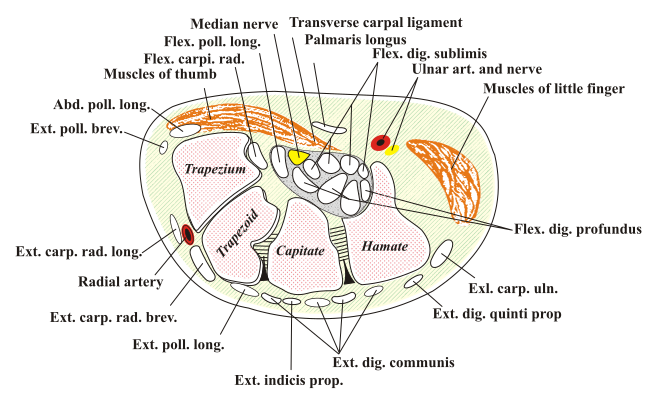- Carpal tunnel or carpal canal is the passageway on the palmar side of the wrist that connects the forearm to the middle compartment of the deep plane of the palm
- The canal is narrow and when any of the nine long flexor tendons passing through it swells or degenerates, the narrowing of the canal often results in the median nerve becoming entrapped or compressed, a medical condition known as carpal tunnel syndrome
- The structures passing through it are
- flexor digitorum profundus (four tendons)
- flexor digitorum superficialis (four tendons)
- flexor pollicis longus (one tendon)
The carpus, the bony elements of the wrist, form an arch which is convex on the dorsal side of the hand and concave on the palmar side. The groove on the palmar side, the sulcus carpi, is covered by the flexor retinaculum, a sheath of tough connective tissue, thus forming the carpal tunnel. The flexor retinaculum is attached radially to the scaphoid tubercle and the ridge of trapezium, and on the ulna side to the pisiform and hook of hammate
The narrowest section of the tunnel is located a centimetre beyond the mid-line of the distal row of carpal bones where the sectional area is limited to 1.6 cm2
The tendons of the flexor digitorum superficialis and profundus pass through a common ulnarsheath, while the tendon of the flexor pollicis longus passes through a separate radial sheath. Themesotendon shared by these tendons is attached to the radial and palmar walls of the carpal tunnel
Superficial to the carpal tunnel and the flexor retinaculum, the ulnar artery and ulnar nerve pass through the ulnar tunnel
Movements in the wrist affects the shape and width of the carpal tunnel. The width decreases considerably during normal range of motion in the wrist and because the carpal bones move in relation to each other with every motion of the hand the bony walls of the tunnel are not rigid. Both flexion and extension increase compression in the carpal tunnel:
- Flexing the wrist causes the flexor retinaculum to move closer to the radius which considerably decreases the cross section of the proximal opening of the tunnel. Additionally, the distal end of the capitate presses into the opening.
- In extreme extension. the lunate constricts the passage as it is pressed toward the interior of the tunnel.


No comments:
Post a Comment